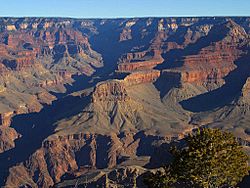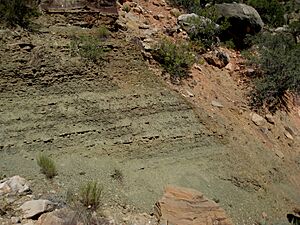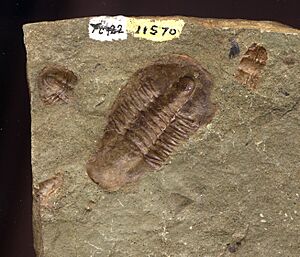Bright Angel Shale facts for kids
Quick facts for kids Bright Angel ShaleStratigraphic range: Middle Cambrian 507–502Ma |
|
|---|---|

Muav Limestone – (dark or light gray, brown, or orange-red subcliff at base of Redwall Limestone cliff) and Bright Angel Shale (greenish slope-former), resting on Tapeats Sandstone (short, dp brown vertical cliff) (Tapeats forms the "Tonto Platform"), inner canyon, Granite Gorge. (The 3 units – Muav, Bright Angel, and Tapeats, are easily seen below the red-stained Redwall Limestone (220 m (720 ft) thick)
|
|
| Type | Geological formation |
| Unit of | Tonto Group |
| Underlies | Muav Limestone |
| Overlies | Tapeats Sandstone |
| Thickness | 67 m (220 ft) at its maximum |
| Lithology | |
| Primary | micaceous siltstone and shale |
| Other | sandstone and glauconitic sandstone |
| Location | |
| Region | northern Arizona, southeast California, southern Nevada, and southcentral Utah |
| Country | United States of America |
| Type section | |
| Named for | Bright Angel Canyon, Bright Angel quadrangle, Coconino Co., Arizona |
| Named by | Noble (1914) |
The Bright Angel Shale is a type of rock layer found in the Grand Canyon, Arizona. It's one of five main rock layers that make up the Tonto Group, which formed during the Cambrian period. You can see the Bright Angel Shale in many parts of the Grand Canyon and other areas like northern Arizona, southeast California, southern Nevada, and southeast Utah.
This rock layer is mostly made of green and red-brown shale (which is like hardened mud) and siltstone. It also has some layers of sandstone and limestone. The Bright Angel Shale can be from 57 to 450 ft (17 to 137 m) thick. Its thin layers of shale and sandstone often stack in small cycles. They also show many cool patterns from ancient water, like ripples. This rock layer slowly blends into the Tapeats Sandstone below it. It also mixes with the Muav Limestone above it. This mixing can make it tricky to tell exactly where one rock layer ends and the next begins. The thin shales and sandstones of the Bright Angel Shale usually form green and red-brown slopes. These slopes rise from the flat Tonto Platform up to the cliffs of the Muav Limestone.
Contents
How It Got Its Name
In 1875, a scientist named G. K. Gilbert noticed some rock layers at the bottom of the Grand Canyon. They looked like other rocks in Arizona called the Tonto Group. He divided the Tonto Group into three parts: the Marbled limestone, the Tonto shale, and the Tonto sandstone.
Later, in 1914, another scientist named L. F. Noble gave these layers new names. He called the Tonto sandstone the Tapeats Sandstone. He renamed the Tonto shale the Bright Angel Shale. He chose the name Bright Angel Shale because this rock layer is very well seen in the walls of Bright Angel Canyon.
In 1922, L. F. Noble also renamed the Marbled limestone. He called it the Muav Limestone. Today, parts of what Noble called the Muav Limestone are known by different names.
Scientists E. D. McKee and C. E. Resser mostly kept Noble's names. They tried to divide the Bright Angel Shale into smaller sections. But these smaller sections turned out to be confusing. So, scientists usually don't use them anymore.
What It Looks Like
In the Grand Canyon, the Bright Angel Shale is a mix of different rocks. It often contains fossils. It's made of layers of shale, mudstone, siltstone, fine-grained sandstone, and some limestone. The most common rock in the Bright Angel Shale is greenish shale. This shale is mostly made of tiny clay minerals.
Some of the sandstone and siltstone layers are reddish-brown. This color comes from tiny iron bits and iron-rich minerals. You can also find some layers of coarse-grained sandstone. These sandstones sometimes have gravel at their bottom. This gravel contains quartz and other rock pieces. A mineral called glauconite also gives many siltstones and sandstones a greenish color. As you go deeper into the Bright Angel Shale, it gets coarser. It has more sandstone layers until it gradually turns into the Tapeats Sandstone.
The siltstones and sandstones in the Bright Angel Shale show many cool patterns. These patterns are called sedimentary structures. They include flat layers, large and small cross-layers, and wavy or lumpy layers. These patterns tell scientists how the rocks formed. The coarse-grained sandstones usually don't have clear layers. They often sit on top of surfaces that were carved out by ancient water.
In the Grand Canyon, the Bright Angel Shale is usually about 110 to 150 m (360 to 490 ft) thick. It's thicker in the western Grand Canyon, over 140 m (460 ft). It gets thinner towards the east, down to about 82 m (269 ft). In Bright Angel Canyon, it's about 100 m (330 ft) thick. The main reason its thickness changes is because it mixes so much with the Muav Limestone above it. South of the Grand Canyon, it gets even thinner, sometimes only a few feet thick.
Ancient Life (Fossils)
The Bright Angel Shale is the most fossil-rich of the five rock layers in the Tonto Group. It has many different kinds of body fossils (parts of ancient creatures). It's also full of trace fossils, which are signs of ancient life like tracks or burrows.
Overall, the body fossils in the Bright Angel Shale are often broken and rare. But some specific layers can have many complete fossils. These layers are as rich in fossils as other Cambrian rock layers in nearby regions. Scientists have found at least 15 different species of trilobites in the Bright Angel Shale. They have also found four types of brachiopods (shellfish). Other finds include one type of hyolith (a cone-shaped creature), four types of possible marine arthropods, and two species of eocrinoids (ancient sea lilies).
The trace fossils in the Bright Angel Shale include tracks and trails made by arthropods. There are also worm burrows and dwelling structures. Some of these have even been given scientific names. Scientists have also found "wrinkle structures" in the Bright Angel Shale. These are special patterns made by tiny living things like microbes.
Where It Formed
At first, scientists thought the Bright Angel Shale formed in the deeper parts of an ancient ocean. This idea came from finding a mineral called glauconite in the rocks. Later, scientists mostly agreed that it formed in a shallow ocean. They thought different layers showed small changes in sea level.
More recently, some scientists think parts of it formed in estuaries (where rivers meet the sea) or tidal flats. These areas are influenced by tides and storms. This idea comes from the types of cross-bedding in the sandstones. It also comes from wavy or lumpy layers, which suggest a changing tidal environment. Also, the main rock type, shale, doesn't have many acritarchs (tiny marine fossils). This suggests there wasn't much ocean influence when the shales formed. However, some shale layers have many well-preserved trilobites and brachiopods. These layers likely formed when sea levels were higher, covering the area with shallow ocean water.
How Old It Is
In 1945, scientists E. D. McKee and C. E. Resser used trilobite fossils to figure out the age of the Bright Angel Shale. They thought the rock layer got younger as you moved from west to east across the Grand Canyon. In their view, the bottom of the Bright Angel Shale was from the late Early Cambrian period in the west. But in the eastern canyon, the whole layer was Middle Cambrian.
However, in 2018, K. Karlstrom and other scientists found new information. They discovered that the Tapeats Sandstone (the layer below) was younger than previously thought. It also didn't get younger to the east. Because of this new finding, scientists now believe the entire Bright Angel Shale layer is from the Middle Cambrian period.
Images for kids
-
Relative long distance photo of Isis Temple (adjacent prominence is Tiyo Point, of the North Rim)
-
(From Komo Point)-Sloping Supai Group redbeds upon Redwall Limestone cliffs and horizontal platforms on the Muav Limestone on (white)-greenish (slopes) of Bright Angel Shale
The rock layers of the Tonto Group, including the colorful Bright Angel Shale, are easy to spot. They are found beneath the tall cliffs of the Redwall Limestone. The Redwall Limestone sits on a short, strong cliff of Muav Limestone. You can also easily see the Tonto Group next to Granite Gorge of the Colorado River and the Vishnu Basement Rocks.
See also
- Geology of the Grand Canyon area
- List of fossiliferous stratigraphic units in Arizona
- Paleontology in Arizona






